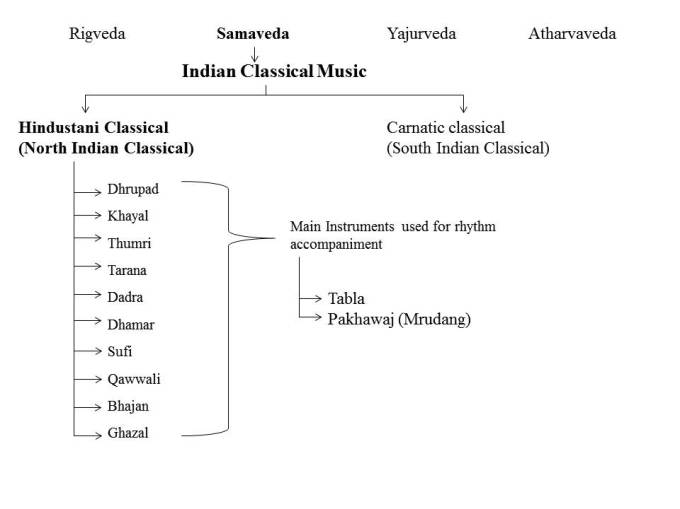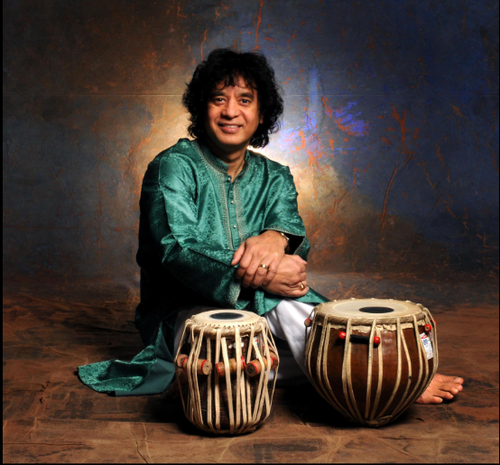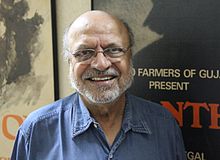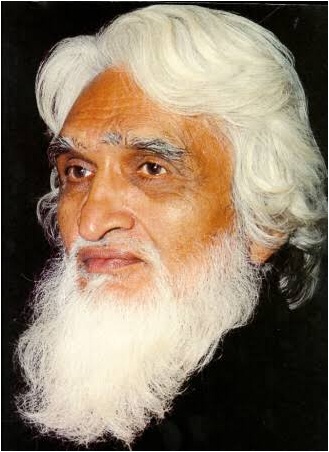
Born: 17 Sept, 1915 at Pandharpur, Maharastra.
Died: 9 June, 2011, in London.
Early Life
Born in 1915, MF Husain came from a traditional Muslim background. He was born in Pandharpur, Bombay Presidency in British India. His mother, Zunaib died when he was one and a half years old. Thereafter, his father, Fida remarried a girl named Shireen and shifted to Indore. Husain was extremely close to his grandfather, from whom he drew his major inspiration. Unfortunately, his grandfather could not accompany him for long as he passed away when Husain was just 6. Husain’s formal education began at Sidhpur in Gujarat where he underwent 2 years of rigorous training in Indian religions. From here, he was transferred to an Islamic boarding school, Darul Talaba in Baroda. However, owing to his miserable performance, his father apprenticed him to a tailor and later to a draughtsman, hoping that he would pick up a profession. Interestingly, his father was very supportive towards his love for art. Seeing his possession and passion for art, he even gifted him an Agfa box camera. When Husain was just 16, his father rented a room in the neighboring house where Husain could paint in complete privacy. He gained interest in English literature, courtesy his neighbor, Yavar, from where he started reading Shakespeare, John Ruskin, and books on British painters.
Early Career Life
In 1935, Husain moved to Mumbai for the first time at the age of 20 and took admission in J.J. School of Arts. He earned his living by painting cinema hoardings and whenever he managed to save some money, he used to travel to Baroda, Surat, and Ahmedabad to paint landscapes. Since painting hoardings did not give him much of an earning, he tried his luck in other jobs. Amongst them, working at the toy factory proved to be the best paying job, where he was engaged in designing and building fretwork toys. After struggling and experiencing hardships for years in Mumbai, Husain finally received recognition in the late 1940s. Though in 1944, he received an offer from Fantasy for designing children’s furniture and later in 1947 from Kamdars, a famous design company, his initial love remained painting.
Career as a Painter
In 1947, Husain’s painting ‘Sunhera Sansaar’ was exhibited at Bombay Art Society for the first time. The same year saw India’s independence, after which, he decided to stay back in India. Soon after, Progressive Artists’ Group (PAG) was formed by the artist Francis Newton Souza. Husain was amongst the early members and became the secretary of the group in 1949. This was just the first step towards the historic success that Husain went on to make later on. His first solo exhibition was held in Zurich in 1952, followed by a series of successful exhibitions across Europe and US. In 1971, he was sent a special invitation along with the legendary Pablo Picasso at the Sao Paulo Biennial. He was nominated at the Rajya Sabha for a term in 1986.
Career as a Filmmaker
Besides earning the title of the most eminent and highest paid Indian painter, Husain also tried his hand at film direction. His first film ‘Through the Eyes of a Painter’ produced in 1967 was victorious in bagging the Golden Bear at the Berlin Film Festival. Husain was so obsessed with the stunning Bollywood actress Madhuri Dixit that he considered her as his muse. He even went ahead to make a film with her, titled ‘Gaja Gamini’ in 2000. Besides, Dixit remained the subject of his numerous paintings, which he titled ‘Fida’. Apart from Dixit, Husain also made a film titled ‘Meenaxi: A Tale of Three Cities’ with Tabu, another Bollywood artiste, in 2004. Amrita Rao and Anushka Sharma are couple of other Bollywood actress who had cast a charm on Husain.
Controversies
Husain was not just renowned for his exemplary paintings and portrayal of human figures, but he was also the center of controversies. His nude portraits of Hindu gods and goddesses or in an allegedly sexual manner captured a lot of eyeballs but all for the wrong reasons. Although the paintings were created in 1970, they did not become an issue till 1996, until they were published in a Hindi monthly magazine, Vichar Mimansa. The very instant response resulted in eight criminal complaints against Husain on the pretext of promoting enmity between Hindu goddesses, Durga and Saraswati, which was dismissed by Delhi High Court. Later in 1998, Hindu groups, like Bajrang Dal attacked his house and destroyed his paintings. The extent of the protests was such intense that his exhibition due in London was called off. In 2004, after the release of his film ‘Meenaxi: A Tale of Three Cities’ starring Tabu, he was objected by some Muslim organizations for using words directly from the Holy Quran in the Qawwali song ‘Noor-un-Ala-Noor’. As a result, the movie was removed from cinema halls, just a day after its release. The complaint, lodged by the All-India Ulema Council, was supported by other Muslim organizations, such as the Milli Council, All-India Muslim Council, Raza Academy, Jamiat-ul-Ulema-e-Hind, and Jamat-e-Islami. Yet again in February 2006, Husain again became the talk of the town when he again painted Bharatmata (Mother India) as a nude woman across the map of India with different Indian state names on various parts of the body. This nude portrayal was highly objected by Hindu Jagriti Samiti and Vishva Hindu Parishad, which resulted in the issue of a non-bailable warrant. Although Husain apologized and withdrew the painting from the auction, the painting was published on his official website. He left India in 2006 and went on a self-imposed exile, settling in Dubai. Later in 2010, he was offered the citizenship of Qatar, which he readily agreed. Thereafter, he had divided his time between homes in Qatar and London.
Cubism
Highly influential visual arts style of the 20th century that was created principally by the artists Pablo Picasso and Georges Braque in Paris between 1907 and 1914. The Cubist style emphasized the flat, two-dimensional surface of the picture plane, rejecting the traditional techniques of perspective, foreshortening, modeling, and chiaroscuro, and refuting time-honoured theories that art should imitate nature. Cubist painters were not bound to copying form, texture, colour, and space; instead, they presented a new reality in paintings that depicted radically fragmented objects.
Progressive Artists’ Group
Founded by Francis Paulo Souza a group of young artists who wished to break with the conservative nationalist traditions established by the Bengal school of art and to encourage a more modern, western influence to create a avant-garde Indian Art, engaged at an international level. This group wanted to experiment new art forms. Husain was invited to be a founder member of this group for his painting Sunhera Sansar.
Hussain on Time Line
1915: Born in Pandharpur, Bombay Presidency, British India
1935: Came to Bombay and joined JJ School of Arts
1941: Married Fazila on March 11
1947: Sunhera Sansaar’ exhibited at Bombay Art Society for the first time
1947: Joined Progressive Arts’ Group (PAG)
1949: Became secretary of PAG
1952: First solo exhibition held in Zurich
1955: Honored with Padma Shree Award
1967: First film ‘Through the Eyes of a Painter’ won a Golden Bear
1971: Invited at the Sao Paulo Biennial, along with Pablo Picasso
1973: Awarded the Padma Bhushan 1986: Nominated to the Rajya Sabha
1991: Bestowed with Padma Vibhushan
1996: Accused of portraying Hindu deities nude in allegedly sexual manner
2000: ‘Gaja Gamini’, featuring his muse Madhuri Dixit, was released
2004: ‘Meenaxi: A City of Three Cities’ was released
2006: Charged with depicting Mother India as a nude woman
2006: Went on a self-imposed exile to Dubai
2008: ‘Battle of Ganga and Jamuna: Mahabharata 12’ successfully fetched $ 1.6 million
2008: Conferred upon with Raja Ravi Verma Award by the Government of Kerala
2010: Accepted Qatar citizenship
2011: Died on June 9 due to a heart attack in London, England
2011: Buried at Brookwood Cemetery
Paintings
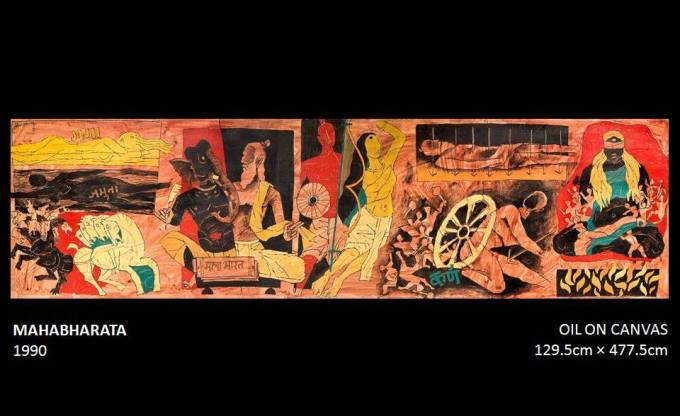
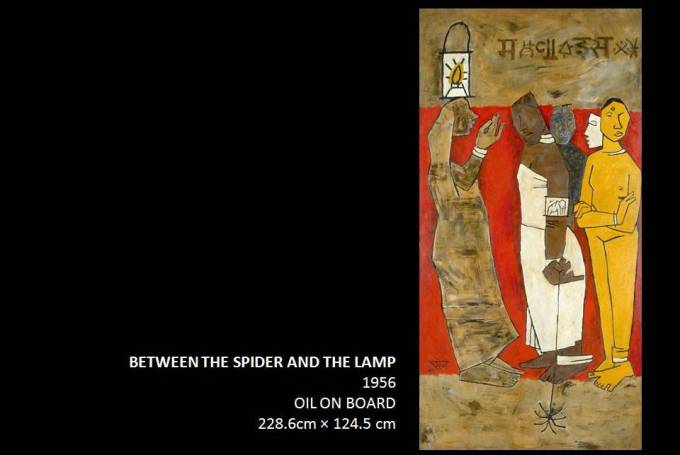
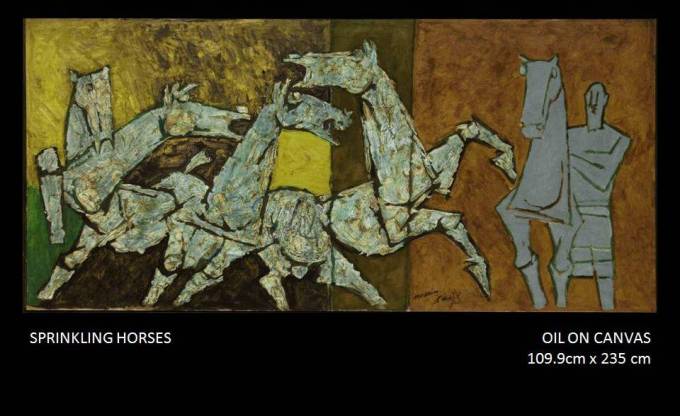
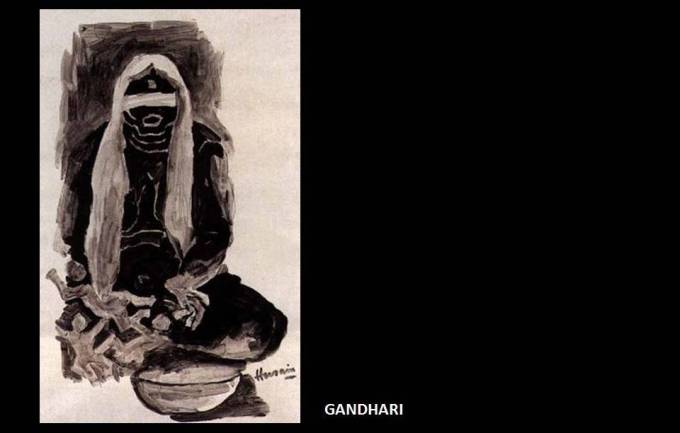
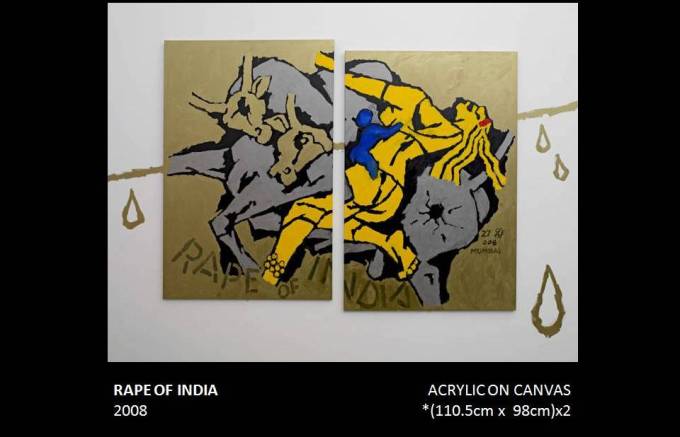
Sources
- culutureindia.com
- artasiapacific.com
- pdf on The Art Of Maqbool Fida Husain by Raina Gangwal for dgm6105 – visual communication foundations – final project
